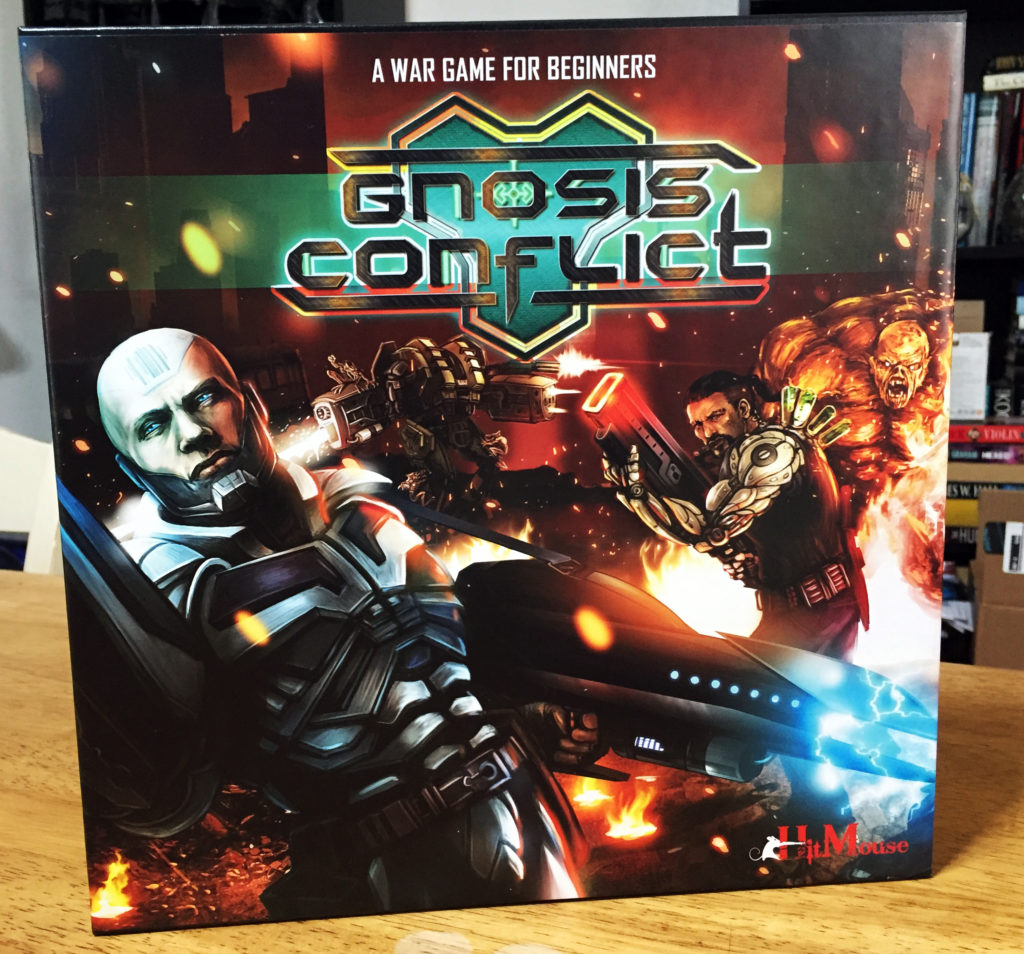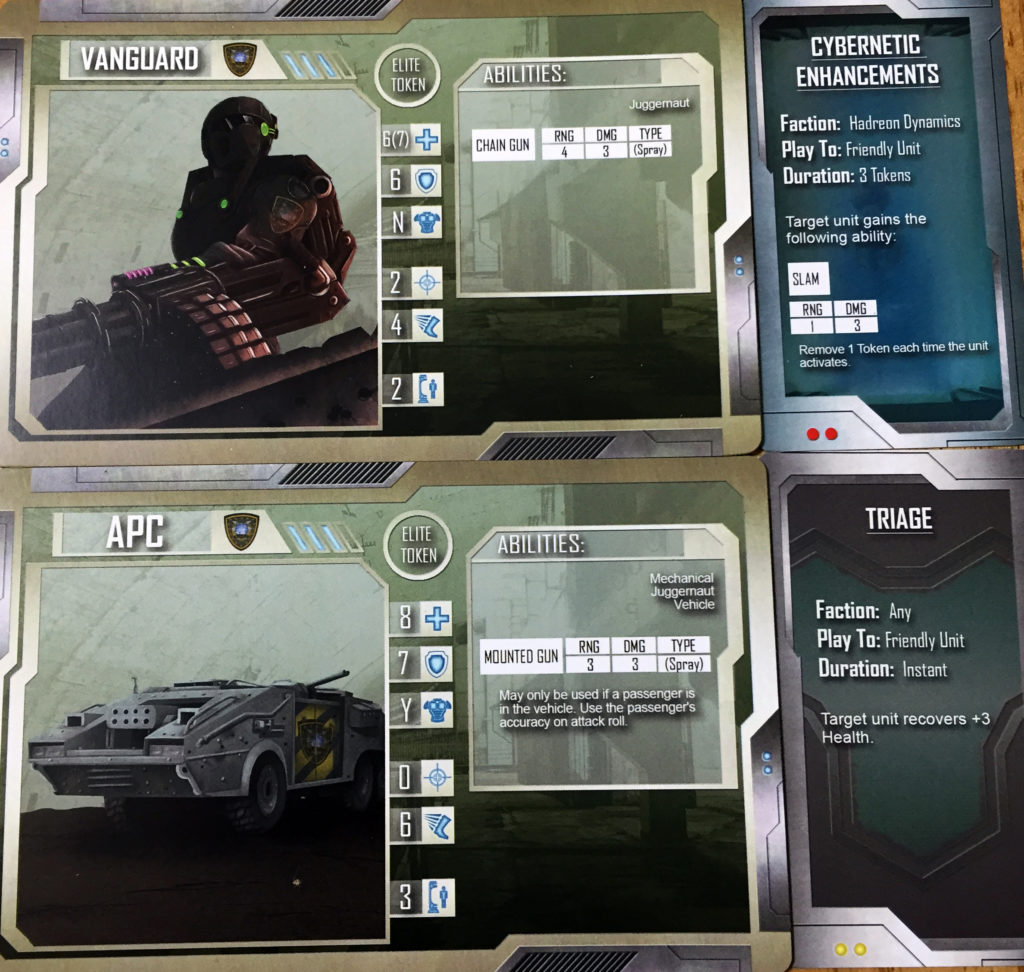In my experience, a lot of war games I come across tend to be rather complicated. Some even take over two hours to play and to be fair, I’ve seen folks at my local game shop play these kinds of games without batting an eye. “Star Wars: X-Wing” is one of the rare few that I have gotten into that offers a ton of content but takes a while to fully understand. “Gnosis Conflict”, a 2-3 player strategy game that will be launching on Kickstarter in July 2016, aims to keep things relatively simple while offering hardcore strategy vets something to think about. I’d like to thank Anthony Gallo from Hitmouse Productions for providing me with a prototype copy for preview purposes. It’s important to stress that prototypes are not often reflective of the final product, making everything you see and read about here subject to change.

The game comes with 32 unit cards (8 units for 4 factions), 4 faction ability cards (1 for each faction), 42 enhancement cards (8 for each of the 4 factions and 2 copies of the 5 general enhancements, 32 unit tokens (with a corpse / wreckage marking on the reverse side), 20 mine tokens (landmines, claymores, replicator virus mines, IEDs, and toxic mines), 7 tech tokens, 7 mitosis tokens, 1 drone token, 3 salvage tokens, 8 grenade tokens, 4 RC car bomb tokens, 20 generic counter tokens, 30 damage/respawn tokens (double-sided), 6 salvage bonus tokens, 12 faction tokens, a 10-sided die, a combat tracker, 12 double-sided environmental terrain pieces, and 4 faction bases/cloning facilities. Needless to say, there’s a lot here to get your war game on.
Before players begin, they’ll have to decide on a game mode: King of the Hill (default mode), Arena, or Capture the Flag. In the default King of the Hill mode, players gain one point on the combat tracker at the end of each round for every piece of salvage their faction controls. The first player to ten points wins. In arena, players earn points for kills with the number of points being equal to the unit point cost of the unit killed. Capture the Flag requires players to carry four pieces of salvage back to their cloning facility to win. I like the fact that there are different game modes available, allowing players to switch off when they feel they need a break from any particular one.
Setting up the game is relatively simple in that players select their faction and agree on a game type, secretly creating an army worth a total of eight points (using only one copy of any unit). Players create an enhancement deck of five cards coming from both their faction deck and the generic supply, shuffle them up, and draw one for their opening hand. Terrain plates are randomly dealt to form the board…in a two player game, 4 are used in a 2×2 pattern whereas 6 are used in a 2×3 pattern with three players. Players take turns placing these tiles together via round order (determined by a die roll). After the board is ready, each player in round order places their cloning facility within accordance to specific placement rules. Units are then placed on their respective facilities.
The game itself is played over a series of rounds with each round consisting of players taking multiple turns. The turn sequence includes: activating a unit not yet activated this turn, taking a free action, moving, using an ability, and resolve. Once the player is done doing these actions with their chosen unit, play passes to the next player. When all units have been activated, the round ends. There’s obviously a bit more to it than that, but that’s the general flow of play.

Rather than detail each and every part of a player’s action (which will admittedly take a while), I’d like to hi-lite some of the things I felt to be most relevant. For example, each unit has its own unique move rating and the terrain will affect how many move points a unit spends to traverse there. Some terrain, like dangerous terrain, cause the unit to suffer damage while others offer defensive and range bonuses. Other terrain can’t be traversed altogether and even block line of sight preventing attacks that would normally be viable. As any war game vet will tell you, it’s all about location, location, location!
Combat is straight forward, with the attacker rolling a D10 then adding any accuracy bonuses. If the total meets or exceeds the defense rating on the target, damage is applied. Some attacks cause special damage effect that players will need to pay attention to. Killed units do respawn at the cloning facility over time, though they lose any tokens, elite status, or enhancement cards they may have. Speaking of cloning facility, players may end their activation on their own cloning facility to heal two points of damage.
Salvage plays a big part in this game too. There are spaces marked on the map that represent pieces of alien technology that are just waiting to be reclaimed by a player. When trying to activate one, the player will roll a D10 and using the chart in the manual, resolve the effect. Some effects cause damage while others allow the player to draw an enhancement card, cause the unit to go elite, or gain defense/accuracy/movement bonuses. No matter which modes you play, these salvage pieces will be crucial to helping you win the game.
“Gnosis Conflict” has a lot going for it. Yes, it does require a bit of thinking so I wouldn’t call it an entry-level war game, what with all the card effects and rules regarding tokens, terrain, and etc. Luckily, you can remove some of these features to make your life easier, if you so choose. It’s your “toy” after all, so customize your play experience the way you want to. The manual does include a suggested setup for your first game, which is nice. All in all, “Gnosis Conflict” is one project you’ll want to follow whether you’re a newcomer or a seasoned vet to the strategy/war-game genre.
—
Kickstarter:
https://www.kickstarter.com/projects/hitmouse/gnosis-conflict-war-gaming-for-beginners
